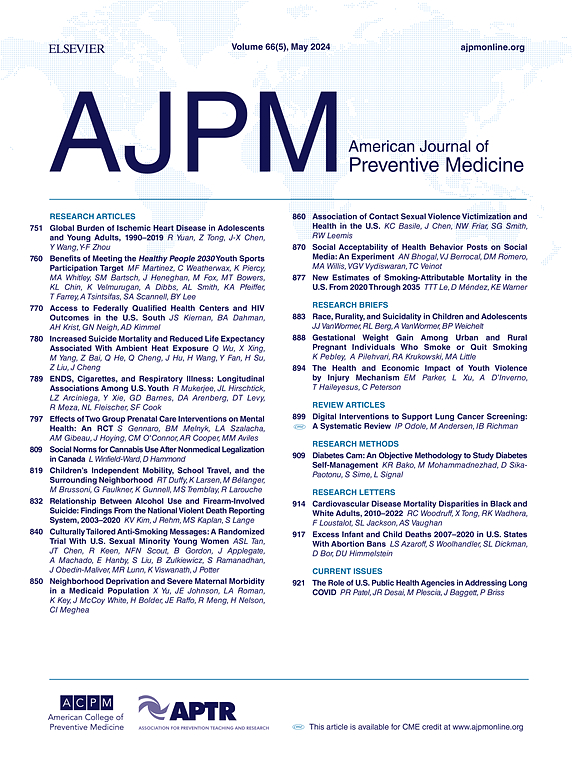Neighborhood Firearm Violence, Psychosocial Risks, and Youth Firearm Perception
IF 4.3
2区 医学
Q1 MEDICINE, GENERAL & INTERNAL
引用次数: 0
Abstract
Introduction
Youth firearm access is associated with psychosocial behaviors, violence, and injury. Some youth without firearms at home perceive they could obtain one, indicating higher risk than those with securely stored firearms. This study examined youth and neighborhood factors associated with perceived firearm availability.
Methods
This cross-sectional study analyzed 23,334 emergency department visits by youth aged 14–18 years completing Behavioral Health Screening (2013–2024) for firearm availability and psychosocial risks. Neighborhood firearm violence and child opportunity index scores were linked to patients’ census tracts. Patient and neighborhood characteristics were compared across groups: no firearm availability, at-home availability, and perceived availability. Mixed-effects models and mediation analyses further examined the associations.
Results
Among 16,174 patients (65% Medicaid insured, 75% in very low child opportunity index neighborhoods), perceived firearm availability was associated with racial/ethnic minority status, reported fighting, retaliation, at-risk substance use, school bullying, intimate partner violence, lower child opportunity index and higher neighborhood firearm violence. At-home firearm availability was linked to non-Hispanic White status, non-Medicaid insurance, emergency department visits for mental health, higher COI, and lower firearm violence (all p<0.001). Among those without firearms at home, fighting (OR=3.6; 95% CI=3.1, 4.3) and high neighborhood firearm violence (OR=1.8; 95% CI=1.5, 2.3) were associated with perceived availability after covariate adjustment. Fighting behaviors mediated 32% of the total effect of neighborhood firearm violence on perceived firearm availability.
Conclusions
Youth fighting and high neighborhood firearm violence were associated with perceived firearm availability, highlighting the connection between violence exposure and firearm perceptions. ED-based screening for perceived firearm availability may help intervene youth firearm carriage and future violence.
邻里枪支暴力,社会心理风险和青少年枪支认知。
青少年获得枪支与心理社会行为、暴力和伤害有关。一些家里没有枪支的年轻人认为他们可以获得枪支,这表明他们比那些安全地存放枪支的人风险更高。我们调查了与感知枪支可用性相关的青少年和社区因素。方法:本横断面研究分析了23,334名14-18岁的急诊科(ED)患者,他们完成了2013-2024年的行为健康筛查,以了解枪支的可获得性和社会心理风险。社区枪支暴力和儿童机会指数(COI)得分与患者的人口普查区有关。患者和社区特征在各组间进行比较:无枪支可用性、在家可用性和感知可用性。混合效应模型和中介分析进一步检验了这些关联。结果:在16174名患者中(65%有医疗补助保险,75%在COI非常低的社区),感知到的枪支可获得性与种族/少数民族身份、报告的打架、报复、危险物质使用、学校欺凌、亲密伴侣暴力、较低的COI和较高的社区枪支暴力有关。家庭枪支的可获得性与非西班牙裔白人身份、非医疗补助保险、精神健康急诊就诊、较高的COI和较低的枪支暴力有关(均p < 0.001)。协变量调整后,在家中没有枪支的人群中,打架(OR=3.6[3.1-4.3])和高邻里枪支暴力(OR=1.8[1.5-2.3])与感知可获得性相关。邻里枪支暴力对感知枪支可得性的总影响中,打斗行为占32%。结论:青少年打架和高邻里枪支暴力与感知到的枪支可得性有关,突出了暴力暴露与枪支感知之间的联系。以ed为基础的可获得性枪支的筛查可能有助于干预青少年携带枪支和未来的暴力行为。
本文章由计算机程序翻译,如有差异,请以英文原文为准。
求助全文
约1分钟内获得全文
求助全文
来源期刊

American Journal of Preventive Medicine
医学-公共卫生、环境卫生与职业卫生
CiteScore
8.60
自引率
1.80%
发文量
395
审稿时长
32 days
期刊介绍:
The American Journal of Preventive Medicine is the official journal of the American College of Preventive Medicine and the Association for Prevention Teaching and Research. It publishes articles in the areas of prevention research, teaching, practice and policy. Original research is published on interventions aimed at the prevention of chronic and acute disease and the promotion of individual and community health.
Of particular emphasis are papers that address the primary and secondary prevention of important clinical, behavioral and public health issues such as injury and violence, infectious disease, women''s health, smoking, sedentary behaviors and physical activity, nutrition, diabetes, obesity, and substance use disorders. Papers also address educational initiatives aimed at improving the ability of health professionals to provide effective clinical prevention and public health services. Papers on health services research pertinent to prevention and public health are also published. The journal also publishes official policy statements from the two co-sponsoring organizations, review articles, media reviews, and editorials. Finally, the journal periodically publishes supplements and special theme issues devoted to areas of current interest to the prevention community.
 求助内容:
求助内容: 应助结果提醒方式:
应助结果提醒方式:


